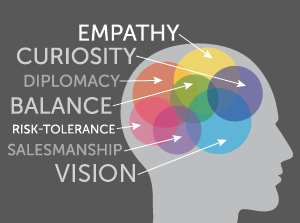The C-suite is often thought of as hesitant to embrace change. While many think the tried-and-true should rule, by selecting like-minded people and favoring analytical over intuitive thinking, the C-suite can quickly lose sight of customer needs. However, truly innovative and in-tune executives know that change needs to happen to stay relevant.
Whether it’s through the inclusion of a chief marketing officer, chief customer officer, or chief design officer, the C-suite can benefit greatly from the addition of design-oriented thinkers. Why? Because in all of these roles, the design-minded executive is focused on what matters most: the customer.
A designer’s raison-d’être, after all, is finding new and innovative ways to attract, engage, retain, surprise, and delight the people who purchase your products and services. And this customer-centric perspective can help the C-suite uncover better audience insights and develop innovative solutions.
Here are just a few of the qualities you can develop in your business by including design thinkers in the C-suite:
1. Empathy
Designers are empathizers by nature. Trained in ethnography, anthropology, and an understanding of the human experience, they’re able to see problems through the lens of the consumer and identify gaps in the customer experience pathway. This is one of the most crucial qualities to nurture in your C-suite if you want to create a customer-focused brand.
2. Curiosity
Tom Kelley, IDEO partner and author of “The Ten Faces of Innovation,” explained that a good designer will be a master of “vuja-de” — the art of entering a familiar situation or environment and seeing it anew, full of fresh possibilities. Design-minded executives are great C-suite additions for this reason, adding endless curiosity for new ideas that can enliven the boardroom.
3. Diplomacy
Lead designers are quite adept at managing stakeholders. They’re often responsible for aligning widely disparate points of view and finding common ground. This experience with compromise and collaboration can prove invaluable to the C-suite in creating a productive executive who doesn’t let ego get in the way of the corporate mission and consumer needs.
4. Balance
Designers naturally strike a balance between right-brained and left-brained thinking. They’re in the practice of dealing with the analytical side of business one minute — like systems design, functionality, and sophisticated technical problems — and with the more intuitive, creative side the next.
Designers are also able to balance perspective when chaos abounds. You need that kind of lateral thinking on your team to wrangle the amorphous into an effective approach. Design thinkers focus equally on creative and business concepts and have the ability to provide a holistic perspective that can lead to deep and successful insights.
5. Risk Tolerance
Members of the C-suite can often develop a risk-averse attitude and a real fear of the unknown. Design thinkers, on the other hand, know just how to break out of this apathy toward risk. Having someone who advocates for bold new ventures will help keep your business moving forward.
6. Salesmanship
Designers know how to sell ideas and get buy-in. To survive in the agency world, design thinkers become masters at selling innovation. Design-oriented people spend their careers outlining the competitive landscape, identifying areas for marketplace disruption, and framing new ideas in terms of corporate transformation. And, as it just so happens, they’re also good at making things pretty.
Believe it or not, most design executives can deftly navigate their way around a spreadsheet and an analytics report. But they can also visualize that data in a way that’s understandable. Sometimes, a picture’s worth a thousand spreadsheets.
7. Vision
One of the most important skills design thinkers can bring to the C-suite is the ability to see the merest kernel of an idea, then grow, launch, and scale that concept through multiple channels. An idea is useless unless it delivers value, and designers are constantly measured on ROI.
Put It Into Practice
While the days of designers being told to become more business-minded and financially savvy still exist, the idea that businesspeople need to strengthen their approaches by adopting design thinking is gaining momentum. New C-level design roles are even emerging. Maria Giudice, an author and the director of product design at Facebook, believes there’s a new breed of executive who is both a strategic thinker and a creative problem solver: the design executive officer.
Redecorating your C-suite with this idea in mind doesn’t have to result in a headache-inducing work environment. When you discover the core traits that experienced design thinkers have mastered — like empathy for the customer, endless inquisitiveness, and the ability to take calculated risks and bring ideas to life with an educated vision — you won’t want to let them go.
Amber Bezahler is Senior Vice President of Marketing at VIOLET GREY. Over the past 20 years, she has held executive roles in marketing, sales, and design, and she has built and managed global teams that continue to deliver rich, omni-channel customer experiences for many of the world’s leading brands, including BMW, Crate & Barrel, DIRECTV, Electronic Arts, Microsoft, Nike, Nintendo, and Starbucks, among many others. She holds over 70 communications awards, has been cited in IdN Magazine for her exceptional approach to developing brand identities, and is a frequent industry speaker and author.
Image Credit:





